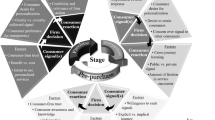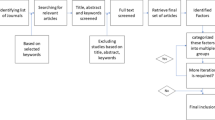Abstract
In this paper, we develop two revelation mechanism models of a supply chain consisting of one manufacturer and one retailer under asymmetric information, where the retailer provides store assistance (SA) to reduce consumer returns rate and increase demand. Under full information, we find that a higher returns rate or returns handling cost increases the SA level if the market scale is sufficiently high. In the demand information asymmetry model, we find that: (i) the low-type retailer (facing a low demand) has no incentive to distort demand information while the high-type retailer may report wrong information; (ii) the manufacturer would like to design a menu of wholesale price-order quantity contract to induce truthful demand information and the manufacturer pays an information rent to the high-type retailer if the returns rate or returns handling cost for the retailer is sufficiently low; (iii) asymmetry of information does not change the monotonicity of the unit wholesale price in the retailer’s type, and information asymmetry decreases the retail price but increases the SA level. Unlike the demand information asymmetry model, a higher retailer’s returns handling cost expands the effects of information asymmetry on the retail price and the SA level, and using revelation mechanism decreases the channel profit if the retailer’s returns handling cost is sufficiently high under the returns rate information asymmetry model.











Similar content being viewed by others
References
Babich, V., Li, H., Ritchken, P., & Wang, Y. (2012). Contracting with asymmetric demand information in supply chains. European Journal of Operational Research, 217, 333–341.
Baron, D., & Myerson, R. (1982). Regulating a monopolist with unknown costs. Econometrca, 50, 911–830.
Burnetas, A., Gilbert, S. M., & Smith, C. E. (2007). Quantity discounts in single-period supply contracts with asymmetric demand information. IIE Transactions, 39, 465–479.
Cachon, G. P., & Lariviere, M. A. (1999). Capacity choice and allocation: Strategic behavior and supply chain performance. Management Science, 45(8), 1091–1108.
Cao, E., Ma, Y., Wan, C., & Lai, M. (2013). Contracting with asymmetric cost information in a dual-channel supply chain. Operations Research Letters, 41, 410–414.
Che, Y. K. (1996). Customer return policies for experience goods. The Journal of Industrial Economics, 44(1), 17–24.
Chen, J. (2011). The impact of sharing customer returns information in a supply chain with and without a buyback policy. European Journal of Operational Research, 213, 478–488.
Chen, J., & Bell, P. C. (2013). The impact of customer returns on supply chain decisions under various channel interactions. Annals of Operations Research, 206(1), 59–74.
Ferguson, M., Guide, V. D. R, Jr, & Souza, G. C. (2006). Supply chain coordination for false failure returns. Manufacturing & Service Operations Management, 8(4), 376–393.
Fudenberg, D., & Tirole, J. (1991). Game theory. Cambridge: Massachusetts Institute of Technology Press.
Gilbert, S. M., & Cvsa, V. (2003). Strategic commitment to price to stimulate downstream innovation in a supply chain. European Journal of Operational Research, 150, 617–639.
Lewis, T. R., & Sappington, D. E. M. (1988). Regulating a monopolist with unknown demand. The American Economic Review, 78(5), 986–998.
Liu, J., & Wang, H. (2013). The equilibrium results analysis in a competing supply chains with consumer returns. Journal of Industrial Engineering and Management, 6(1), 149–162.
Mukhopadhyay, S. K., & Setaputra, R. (2007). A dynamic model for optimal design quality and return policies. European Journal of Operational Research, 180, 1144–1154.
Mukhopadhyay, S. K., Zhu, X. W., & Yue, X. H. (2008). Optimal contract design for mixed channels under information asymmetry. Production and Operations Management, 17(6), 641–650.
Myerson, R. (1979). Incentive compatibility and the bargaining problem. Econometrica, 47, 61–73.
Ofek, E., Katona, Z., & Sarvary, M. (2011). “Bricks and clicks”: The impact of product returns on the strategies of multichannel retailers. Marketing Science, 30(1), 42–60.
Ramanathan, R. (2011). An empirical analysis on the influence of risk on relationships between handling of product returns and customer loyalty in E-commerce. International Journal of Production Economics, 130, 255–261.
Sanburn, J. (2011). Black Friday remorse: Consumers already returning holiday purchases. http://business.time.com/2011/12/16/black-friday-remorse-consumers-already-returning-holiday-purchases/. Retrieved June 29, 2013
Sappington, D. E. M., & Sibley, D. S. (1988). Regulating without cost information: The incremental surplus subsidy scheme. International Economic Review, 29(2), 297–306.
Xiao, T. J., & Qi, X. T. (2012). A two-stage supply chain with demand sensitive to price, delivery time, and reliability of delivery. Annals of Operations Research. doi:10.1007/s10479-012-1085-6
Xiao, T. J., & Yang, D. Q. (2009). Risk sharing and information revelation mechanism of a one-manufacturer and one-retailer supply chain facing an integrated competitor. European Journal of Operational Research, 196, 1076–1085.
Xiao, T. J., Shi, K. R., & Yang, D. Q. (2010). Coordination of a supply chain with consumer return under demand uncertainty. International Journal of Production Economics, 124, 171–180.
Xiao, T. J., Yang, D. Q., & Shen, H. C. (2011). Coordinating a supply chain with a quality assurance policy via a revenue-sharing contract. International Journal of Production Research, 49(1), 99–120.
Yue, X. H., & Raghunathan, S. (2007). The impacts of the full returns policy on a supply chain with information asymmetry. European Journal of Operational Research, 180(2), 630–647.
Acknowledgments
We would like to thank the two anonymous referees and the guest editors for their many helpful suggestions and insightful comments, which have significantly improved the presentation of this paper. This research was supported in part by (i) the National Natural Science Foundation of China under Grants 71371093 and 70971060; (ii) the University Research Innovation Plan of Jiangsu Province for Doctorial Student under Grant CXZZ13_0065; and (iii) China Scholarship Plan.
Author information
Authors and Affiliations
Corresponding author
Appendix
Appendix
Proof of Proposition 1
The Hessian matrix of the retailer’s profit over \((p,s)\) is
which is negatively definite if \(\eta >(h_C +h_R )^{2}\lambda ^{2}/2\). Solving the first-order conditions \(\partial \pi _{Ri} /\partial p=0\) and \(\partial \pi _{Ri} /\partial s=0\) for \((p,s)\), we have
Inserting \(p_i (w)\) and \(s_i (w)\) into (3), we have
which is a concave function of \(w\) following from \(\eta >h_T^2 \lambda ^{2}/2\). Solving the first-order condition \(\partial \pi _{Mi} (w)/\partial w=0\), we have \(w_{i0}^{*} =(c+\overline{{v}}_i -h_T \lambda )/2\). Further, we can complete the proof. \(\square \)
Proof of Lemma 2
Differentiating \(\pi _{Ri1} (s_{i1} ,w_j )\) twice with respect to \(s_{i1}\), we have \(\partial ^{2}\pi _{Ri1} (s_{i1} ,w_j )/\partial s_{i1}^2 =-\eta <0\), i.e., the second-order condition is satisfied. By solving the first-order condition \(\partial \pi _{Ri1} (s_{i1} ,w_j )/\partial s_{i1} =h_T \lambda q_j (w_j )-\eta s_{i1} =0\), we have \(s_{i1} (w_j )=h_T \lambda q_j (w_j )/\eta \). Further, we have
Therefore, we can obtain the maximum profit of the type-\(i\) retailer \(\pi _{Ri1} (w_j )\).
\(\square \)
Proof of Proposition 2
Part (i) Differentiating \(\pi _{Ri1} (w_j )\) twice with respect to \(w_j \), we have
i.e., \(\pi _{Ri1} (w_j )\) is a convex function of \(w_j \). Note that \(\pi _{Ri1} (\overline{{v}}_j -\lambda h_T )=0\),
Further, we have \(\pi _{RL1} (w_H )>0\) for \(w_H <\hat{{w}}_{H-} \) and \(\pi _{RH1} (w_L )>0\) for \(w_L <\overline{{v}}_L -{h}_{T}\lambda \). Note that the manufacturer always offers a unit wholesale price \(w_L <\overline{{v}}_L -{h}_{T}\lambda \) to induce a positive order of the retailer. Thus, we have \(\pi _{RH1} (w_L )>0\).
Part (ii) From Proposition 1, we know that the unit wholesale price for the type-\(H \)retailer should be higher than that for the type-\(L\) retailer under the asymmetric market scale, i.e., \(w_H >w_L \). If \(w_H \ge \hat{{w}}_{H-} \), we have \(\pi _{RL1} (w_H )\le 0\), where \(\pi _{RL} (w_L )>\pi _{RL1} (w_H )\). From Proof of Proposition 2(i), we see that if \(w_H <\hat{{w}}_{H-} \), \(\pi _{RL1} (w_H )\) is a decreasing function of \(w_H \). Thus, we have \(\pi _{RL1} (w_L )>\pi _{RL1} (w_H )\). However, from Lemmas 1 and 2, it follows that \(\pi _{RL} (w_L )-\pi _{RL1} (w_L )=\frac{(\overline{{v}}_H\,-\,\overline{{v}}_L )^{2}\eta }{2(2\eta \, -\,h_T^2 \lambda ^{2})}>0\). Thus, we have \(\pi _{RL} (w_L )>\pi _{RL1} (w_L )>\pi _{RL1} (w_H )\), i.e., the type-\(L\) retailer has no incentive to report wrong demand information.
Part (iii) We see that the type-\(H\)retailer has an incentive to report wrong market scale information if \(\pi _{RH} (w_H )<\pi _{RH1} (w_L )\), i.e., \(\frac{\eta (\overline{{v}}_H\, -\,w_H\, -\,h_T \lambda )^{2}}{2(2\eta \, -\,h_T^2 \lambda ^{2})}<\pi _{RH1} (w_L )\). According to \(\eta >h_T^2 \lambda ^{2}/2\), \(\overline{{v}}_H -w_H -h_T \lambda >0\), and \(\pi _{RH1} (w_L )>0\), we can rewrite it as
\(\overline{{v}}_H -w_H -h_T \lambda <\sqrt{2(2-h_T^2 \lambda ^{2}/\eta )\cdot \pi _{RH1} (w_L )}.\) \(\square \)
Proof of Proposition 3
From (5), it follows that the Hessian matrix of the manufacturer’s profit over \((w_L ,w_H )\) is
which is negatively definite following from \(\eta >h_T^2 \lambda ^2 /2\) and \(0<\alpha <1\). That is, the second-order condition is satisfied. Similar to Proposition 1, we obtain the unit wholesale price for the type-\(L\) retailer \(w_{L0}^{*} \). When constraint (6) is binding, we have \(\hat{{w}}_H =\overline{{v}}_H -h_T \lambda -\sqrt{2(2-h_T^2 \lambda ^{2}/\eta )\cdot \pi _{RH1} (w_{L0}^{*} )}\).
From Lemma 1, \(\eta >h_T^2 \lambda ^{2}/2\) and \(\overline{{v}}_H -w_H -h_T \lambda >0\), it follows that \(\pi _{RH} (w_H )<\pi _{RH} (w_{L0}^{*} )\) for \(w_H >w_{L0}^{*} \). Moreover, we have
Further, it follows that \(\hat{{w}}_H >w_{L0}^{*} \) because \(\pi _{RH} (w_H )\) decreases with \(w_H \).
Now, we show that the manufacturer has an incentive to design a revelation mechanism. If the manufacturer does not design the revelation mechanism, the type-\(H\) retailer may have an incentive to choose the contract \((w_{L0}^{*} ,q_L (w_{L0}^{*} ))\). Note that \(\min \{w_{H0}^{*} ,\hat{{w}}_H \}>w_{L0}^{*} \) and the type-\(L\) retailer chooses the right contract. We only need to show that
We show this inequality as follows: From Proposition 1, we see that \(q_H (w_{H0}^{*} )=q_{H0}^{*} >q_{L0}^{*} =q_L (w_{L0}^{*} )\) because of \(\overline{{v}}_H >\overline{{v}}_L \) and \(\eta >h_T^2 \lambda ^{2}/2\). Further, we have \(q_H (\min \{w_{H0}^{*} ,\hat{{w}}_H \})>q_H (w_{H0}^{*} )>q_L (w_{L0}^{*} )\). \(\square \)
Proof of Proposition 4
Similar to Lemma 2, when the type-\(i\) retailer reports wrong type information, its optimal profit is
which is a convex function of \(w_j \) following from \(\eta >h_T^2 (2\lambda _H^2 -\lambda _L^2 )/2\) and \(\lambda _H >\lambda _L >0\).
Similar to Proposition 2(i), we can show that \(\overline{{\pi }}_{RH2} (w_L )\) is positive and decreases with \(w_L \) for \(w_L <\hat{{\overline{{w}}}}_{L-} \), and \(\overline{{\pi }}_{RL2} (w_H )>0\), where \(\hat{{\overline{{w}}}}_{L-} \) is the minimum positive root of \(\overline{{\pi }}_{RH2} (w_L )=0\).
Part (i) The type-\(L\)retailer has a incentive to report wrong type information if \(\overline{{\pi }}_{RL} (w_L )<\overline{{\pi }}_{RL2} (w_H )\), i.e.,
Since \(\eta >h_T^2 \lambda _L^2 /2\) and \(\overline{{v}}-w_L -h_T \lambda _L >0\), we can rewrite (11) as
Part (ii) Note that under full basic returns rate information, the unit wholesale price for the type-\(L\) retailer is higher than that for the type-\(H\) retailer. Thus, under the revelation mechanism, the unit wholesale prices should satisfy \(w_L >w_H \). Note that \(\overline{{\pi }}_{RH2} (w_L )\le 0\) for \(w_L \ge \hat{{\overline{{w}}}}_{L-} \). We only need to consider the case with \(w_L <\hat{{\overline{{w}}}}_{L-} \). Note that \(\overline{{\pi }}_{RH2} (w_L )\) decreases with \(w_L \) for \(w_L <\hat{{\overline{{w}}}}_{L-} \). Thus, we have \(\overline{{\pi }}_{RH2} (w_H )>\overline{{\pi }}_{RH2} (w_L )\). From Lemma 3 and \(\eta >h_T^2 \lambda _H^2 /2\), we have
Thus, we have \(\overline{{\pi }}_{RH} (w_H )>\overline{{\pi }}_{RH2} (w_H )>\overline{{\pi }}_{RH2} (w_L )\). \(\square \)
Proof of Proposition 5
From (9), we see that the Hessian matrix of the manufacturer profit over \((w_L ,w_H )\) is
which is negatively definite following from \(\eta >h_T^2 (2\lambda _H^2 -\lambda _L^2 )/2>h_T^2 \lambda _H^2 /2\) and \(0<k<1\). That is, the second-order condition is satisfied.
Similar to Proposition 1, we obtain the unit wholesale price for the type-\(H\) retailer \(\overline{{w}}_{H0}^{*} \). Inserting \(\overline{{w}}_{H0}^{*} \) into (10), and then solving the binding constraint (10), we obtain \(\hat{{\overline{{w}}}}_L \). Similar to Proposition 3, we can show that \(\hat{{\overline{{w}}}}_L >\overline{{w}}_{H0}^{*} \) and the manufacturer has an incentive to design a revelation mechanism. \(\square \)
Rights and permissions
About this article
Cite this article
Xiao, T., Shi, J. Consumer returns reduction and information revelation mechanism for a supply chain. Ann Oper Res 240, 661–681 (2016). https://doi.org/10.1007/s10479-014-1592-8
Published:
Issue Date:
DOI: https://doi.org/10.1007/s10479-014-1592-8




